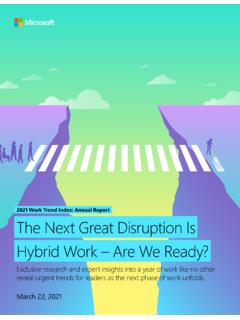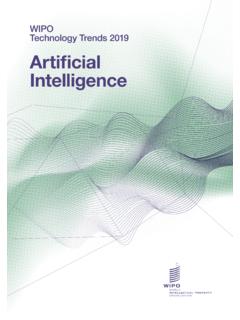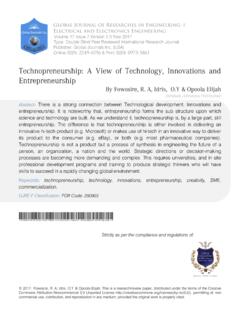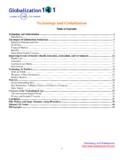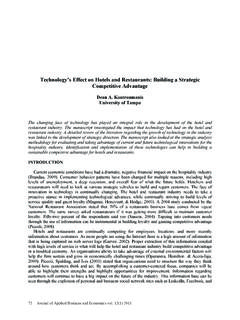Transcription of January 12, 2022
1 1 technology Can Help Unlock a New Future for Frontline WorkersNew data shows that now is the time to empower the frontline with the right digital toolsWork Trend Index: Special ReportJanuary 12, 2022 IIllustration by Bernardo Henning2 Work Trend Index: Special ReportOver the past two years, in order to inform the ways in which our technology solutions can better support our customers needs, Microsoft has continued to study how work is changing. Now, as we look ahead to 2022, we re doing a deep dive on a segment of the workforce that never went home to work the 80 percent of the global workforce, no one has borne the burden of the past two years more than the 2 billion frontline workers around the globe.
2 They ve kept grocery stores stocked, ensured the power grid stayed up and running, provided essential healthcare services, and made and distributed the products the world depends on all while weathering personal risk and ongoing disruption. And as the world continues to endure economic and pandemic uncertainty, many businesses face the near-impossible challenge of keeping the doors open while ensuring the wellbeing of their essential role in every industry, these workers have traditionally been underserved by technology . Just as the pandemic was a catalyst for spurring rapid digital transformation for information workers, the data suggests we re at a similar inflection point on the frontline.
3 This Special Report part of our ongoing Work Trend Index explores findings from a survey of 9,600 frontline employees and man-agers in eight industries across five continents. The data helps shed light on the challenges impacting nearly every business right now, and while technology is not the only solution, the report also reveals an opportunity for digital tools to help ease the burden on these essential workers. The pandemic has put incredible strain on frontline workers, says Jared Spataro, corpo-rate vice president of Modern Work at Microsoft. But across all of our research, we are getting a clear signal about the opportuni-ty to align business outcomes with the wellbe-ing and growth of employees.
4 And it s encour-aging to see that technology can help. 3 Work Trend Index: Special Report1A culture of caring is the new currency on the frontline Seventy-six percent of workers feel bonded to each other, yet over 60 percent say their company could do more to prioritize culture and communication from the top. In addition, 51 percent of those in non- management positions on the frontline don t feel valued as workers are at an inflection pointAmid the Great Reshuffle, frontline workers cite better pay and benefits, work-life balance, and flexibility as reasons for considering a job for tech is highSixty-three percent of frontline workers are excited about the job opportunities technology creates.
5 And technology ranks third on the list of factors that workers say could help reduce workplace s an opportunity to bridge the tech and training gapForty-six percent of frontline workers feel pressure to adapt to new technology over fear of losing their jobs and 55 percent say they ve had to learn new tech on the fly, with no formal training or practice. 3 Key FindingsWork Trend Index: Special Report4 Work Trend Index: Special ReportA culture of caring is the new currency on the frontline14 62%of all frontline workers say leadership does not prioritize building cultureWork Trend Index: Special Report5 Work Trend Index: Special Reporticrosoft Chairman and CEO Satya Nadella talks about the importance of strengthening the connections between employees, a company s mission, and their managers.
6 Our research shows that the pandemic has strengthened some of these ties, while fraying others. To weather the storm, frontline workers have turned to each other. Seventy-six percent report that they feel very bonded to co-workers because of shared stresses brought on by the pandemic. But their connections to leadership and company culture are weak. Sixty-two percent of all frontline workers say that leadership does not prioritize building workplace culture and that jumps to 68 percent for those in management positions on the frontline such as department heads, store managers, and shop-floor , communication isn t trickling down or bubbling up.
7 Sixty-three percent of all frontline workers say messages from leadership don t make it to them. Things are especially trying for frontline managers (69 percent) who say their higher-ups are not effectively communicating with them either. At the same time, 32 percent of frontline workers feel their voice is not being heard when communicating workplace Work Trend Index: Special ReportWorkers see a culture and communication gapWhile frontline workers say they feel more bonded to one another, most say culture and communication need to be better prioritized from the topIllustration by Valerio Pellegrini7 Work Trend Index: Special ReportChoosing the right communication platform can strengthen workplace connections.
8 For example, Blum, a family-run furniture fitting company, once relied on supervisors and a factory floor notice board to share updates with employees. Today, Blum uses the employee experience platform Microsoft Viva to centralize company news, tasks, and conversations, giving frontline workers a consistent connection to the larger company that they can access from anywhere. This isn t just about one-way communication, says Sarah Blum, employer branding and recruiting frontline workers globally cite workload (45 percent), low wages (44 percent), long workdays (41 percent), managing needs of customers (35 percent), and COVID-19 protocols (33 percent) as the top five reasons for their work-related stress.
9 The pandemic has created an extraordinary strain on the individuals on the frontlines, says Dr. David Rhew, global chief medical officer for Microsoft, whose own frontline experience informs Microsoft s healthcare offerings. Beyond the very real effects of COVID on peoples lives and livelihoods, there s the baseline administrative burden they have to handle, and then the workforce is diminishing so there s more and more work being placed on top of them. It s just created an extraordinary amount of pressure and stress. specialist at Blum. We can have direct conversations with employees and answer their questions, and they feel heard.
10 And as companies balance pandemic realities with employee needs, the research shows an opportunity to focus more on the wellbeing of frontline workers. Fifty-one percent of frontline workers in non-management positions don t feel valued as employees, and many workers (60 percent) wish more was being done to help with physical exhaustion or to support mental health (57 percent). Those on the frontline are feeling the pressure of external challenges, too. Most workers surveyed feel more could be done to help supply chain issues (52 percent), and say that labor shortages are making their jobs especially difficult (51 percent).
